E-Waste Management: Assessment and Recommendations for TCN Nigeria
VerifiedAdded on 2023/06/11
|23
|5754
|371
Report
AI Summary
This report assesses e-waste disposal practices in Nigeria, particularly focusing on the Transmission Company of Nigeria (TCN) and its impact on the environment and human health. It highlights the hazardous nature of e-waste, including toxic materials like cadmium, lead, and mercury, and their effects on soil, water, and air quality. The report reviews international waste management legislations and evaluates Nigeria's e-waste management practices, considering factors such as population, household size, and economic activity. It recommends sustainable e-waste management strategies, including recycling technologies, dismantling and demolition processes, and complementary services to mitigate the environmental and health risks associated with improper e-waste disposal. The report concludes by emphasizing the need for government and stakeholder collaboration to implement robust e-waste management strategies and promote environmental sustainability.
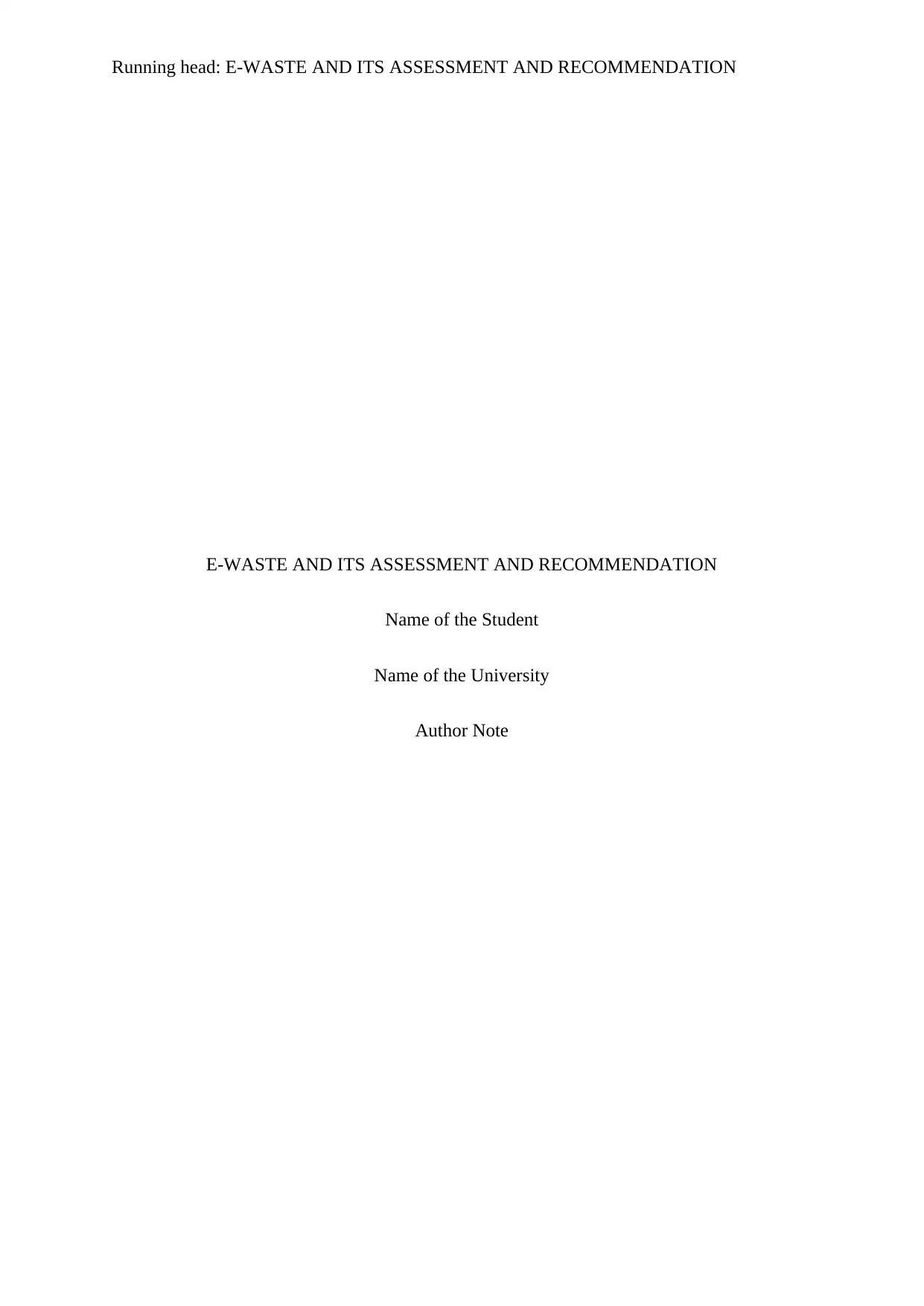
Running head: E-WASTE AND ITS ASSESSMENT AND RECOMMENDATION
E-WASTE AND ITS ASSESSMENT AND RECOMMENDATION
Name of the Student
Name of the University
Author Note
E-WASTE AND ITS ASSESSMENT AND RECOMMENDATION
Name of the Student
Name of the University
Author Note
Paraphrase This Document
Need a fresh take? Get an instant paraphrase of this document with our AI Paraphraser
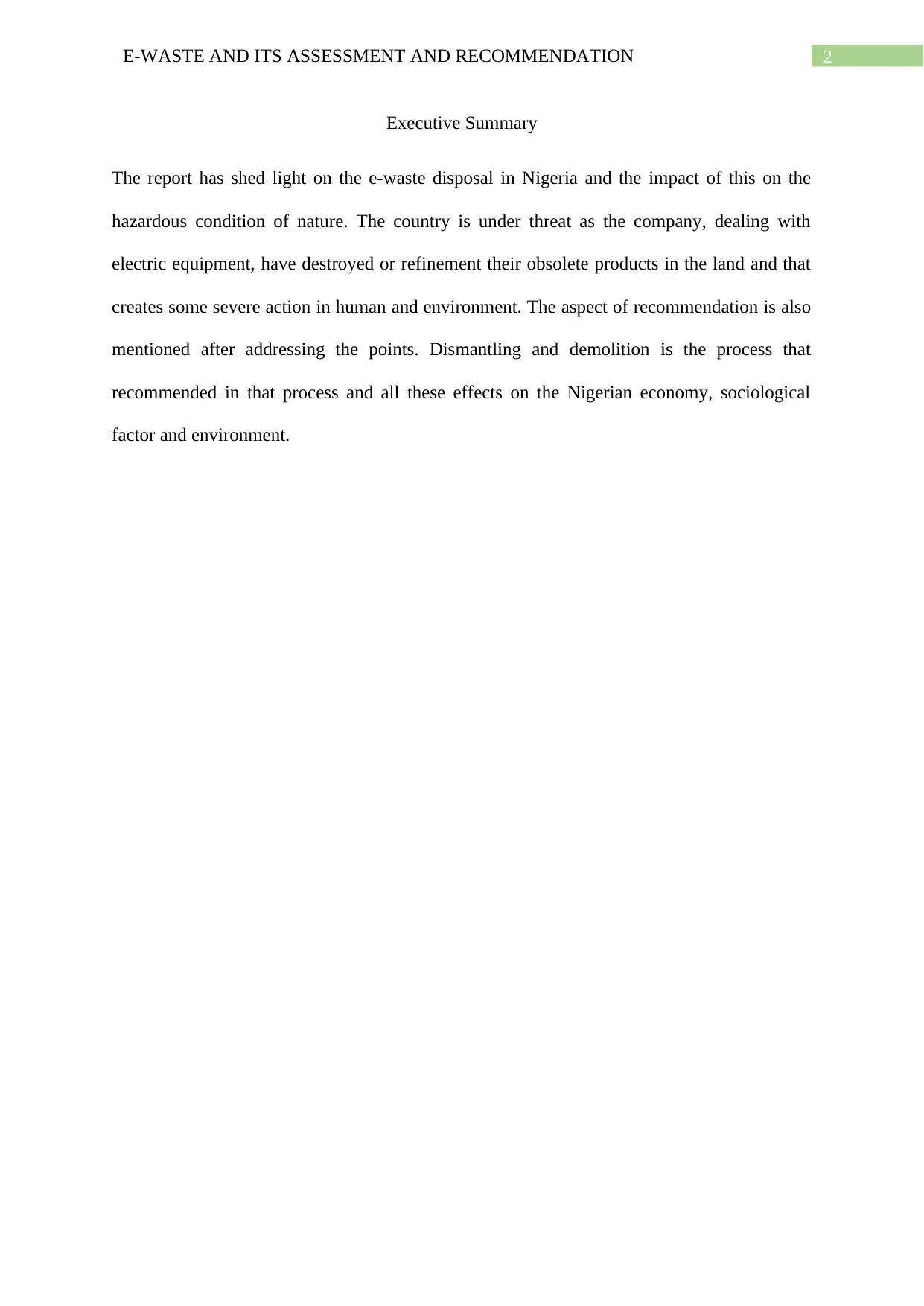
2E-WASTE AND ITS ASSESSMENT AND RECOMMENDATION
Executive Summary
The report has shed light on the e-waste disposal in Nigeria and the impact of this on the
hazardous condition of nature. The country is under threat as the company, dealing with
electric equipment, have destroyed or refinement their obsolete products in the land and that
creates some severe action in human and environment. The aspect of recommendation is also
mentioned after addressing the points. Dismantling and demolition is the process that
recommended in that process and all these effects on the Nigerian economy, sociological
factor and environment.
Executive Summary
The report has shed light on the e-waste disposal in Nigeria and the impact of this on the
hazardous condition of nature. The country is under threat as the company, dealing with
electric equipment, have destroyed or refinement their obsolete products in the land and that
creates some severe action in human and environment. The aspect of recommendation is also
mentioned after addressing the points. Dismantling and demolition is the process that
recommended in that process and all these effects on the Nigerian economy, sociological
factor and environment.
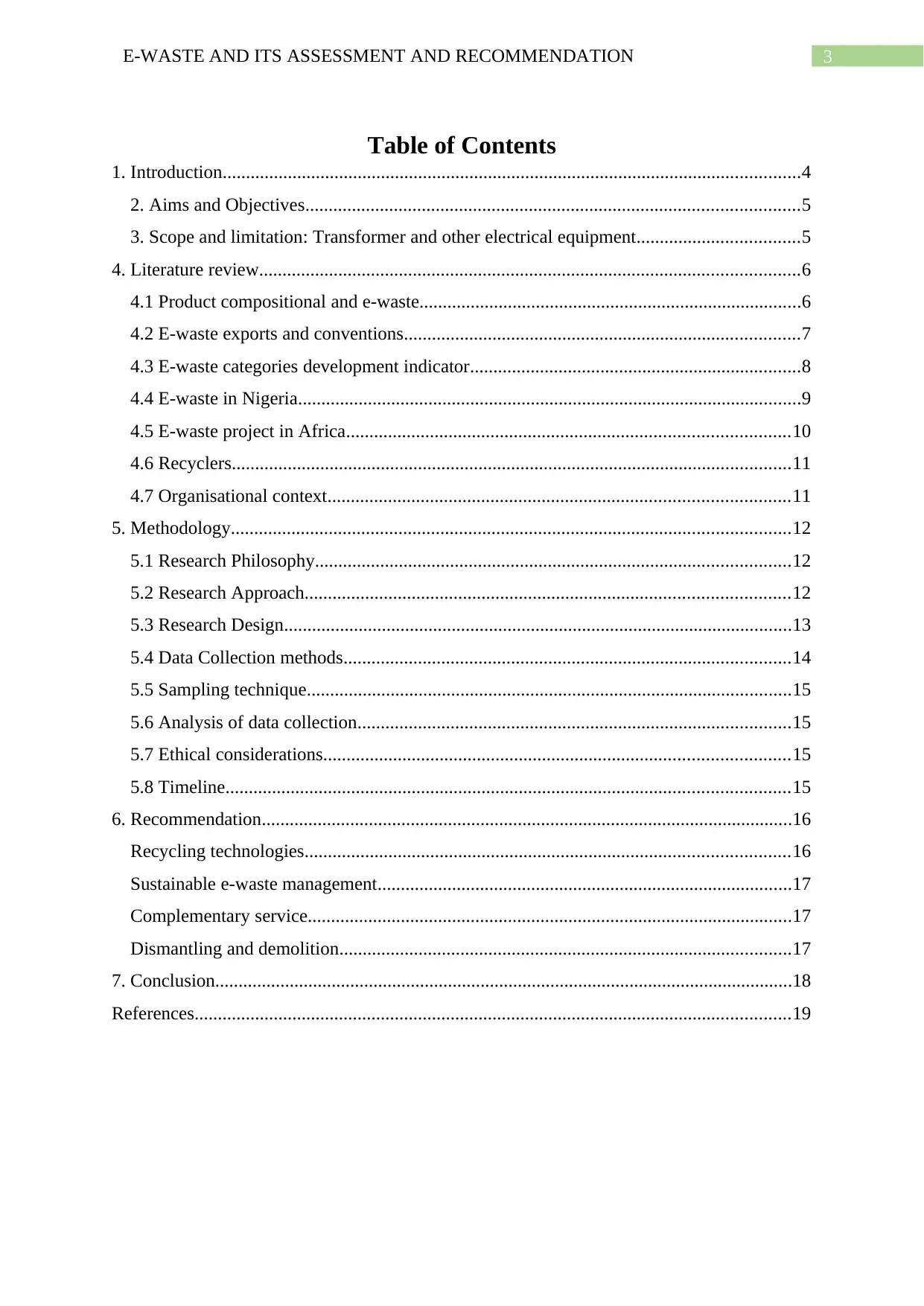
3E-WASTE AND ITS ASSESSMENT AND RECOMMENDATION
Table of Contents
1. Introduction............................................................................................................................4
2. Aims and Objectives..........................................................................................................5
3. Scope and limitation: Transformer and other electrical equipment...................................5
4. Literature review....................................................................................................................6
4.1 Product compositional and e-waste..................................................................................6
4.2 E-waste exports and conventions.....................................................................................7
4.3 E-waste categories development indicator.......................................................................8
4.4 E-waste in Nigeria............................................................................................................9
4.5 E-waste project in Africa...............................................................................................10
4.6 Recyclers........................................................................................................................11
4.7 Organisational context...................................................................................................11
5. Methodology........................................................................................................................12
5.1 Research Philosophy......................................................................................................12
5.2 Research Approach........................................................................................................12
5.3 Research Design.............................................................................................................13
5.4 Data Collection methods................................................................................................14
5.5 Sampling technique........................................................................................................15
5.6 Analysis of data collection.............................................................................................15
5.7 Ethical considerations....................................................................................................15
5.8 Timeline.........................................................................................................................15
6. Recommendation..................................................................................................................16
Recycling technologies........................................................................................................16
Sustainable e-waste management.........................................................................................17
Complementary service........................................................................................................17
Dismantling and demolition.................................................................................................17
7. Conclusion............................................................................................................................18
References................................................................................................................................19
Table of Contents
1. Introduction............................................................................................................................4
2. Aims and Objectives..........................................................................................................5
3. Scope and limitation: Transformer and other electrical equipment...................................5
4. Literature review....................................................................................................................6
4.1 Product compositional and e-waste..................................................................................6
4.2 E-waste exports and conventions.....................................................................................7
4.3 E-waste categories development indicator.......................................................................8
4.4 E-waste in Nigeria............................................................................................................9
4.5 E-waste project in Africa...............................................................................................10
4.6 Recyclers........................................................................................................................11
4.7 Organisational context...................................................................................................11
5. Methodology........................................................................................................................12
5.1 Research Philosophy......................................................................................................12
5.2 Research Approach........................................................................................................12
5.3 Research Design.............................................................................................................13
5.4 Data Collection methods................................................................................................14
5.5 Sampling technique........................................................................................................15
5.6 Analysis of data collection.............................................................................................15
5.7 Ethical considerations....................................................................................................15
5.8 Timeline.........................................................................................................................15
6. Recommendation..................................................................................................................16
Recycling technologies........................................................................................................16
Sustainable e-waste management.........................................................................................17
Complementary service........................................................................................................17
Dismantling and demolition.................................................................................................17
7. Conclusion............................................................................................................................18
References................................................................................................................................19
⊘ This is a preview!⊘
Do you want full access?
Subscribe today to unlock all pages.

Trusted by 1+ million students worldwide
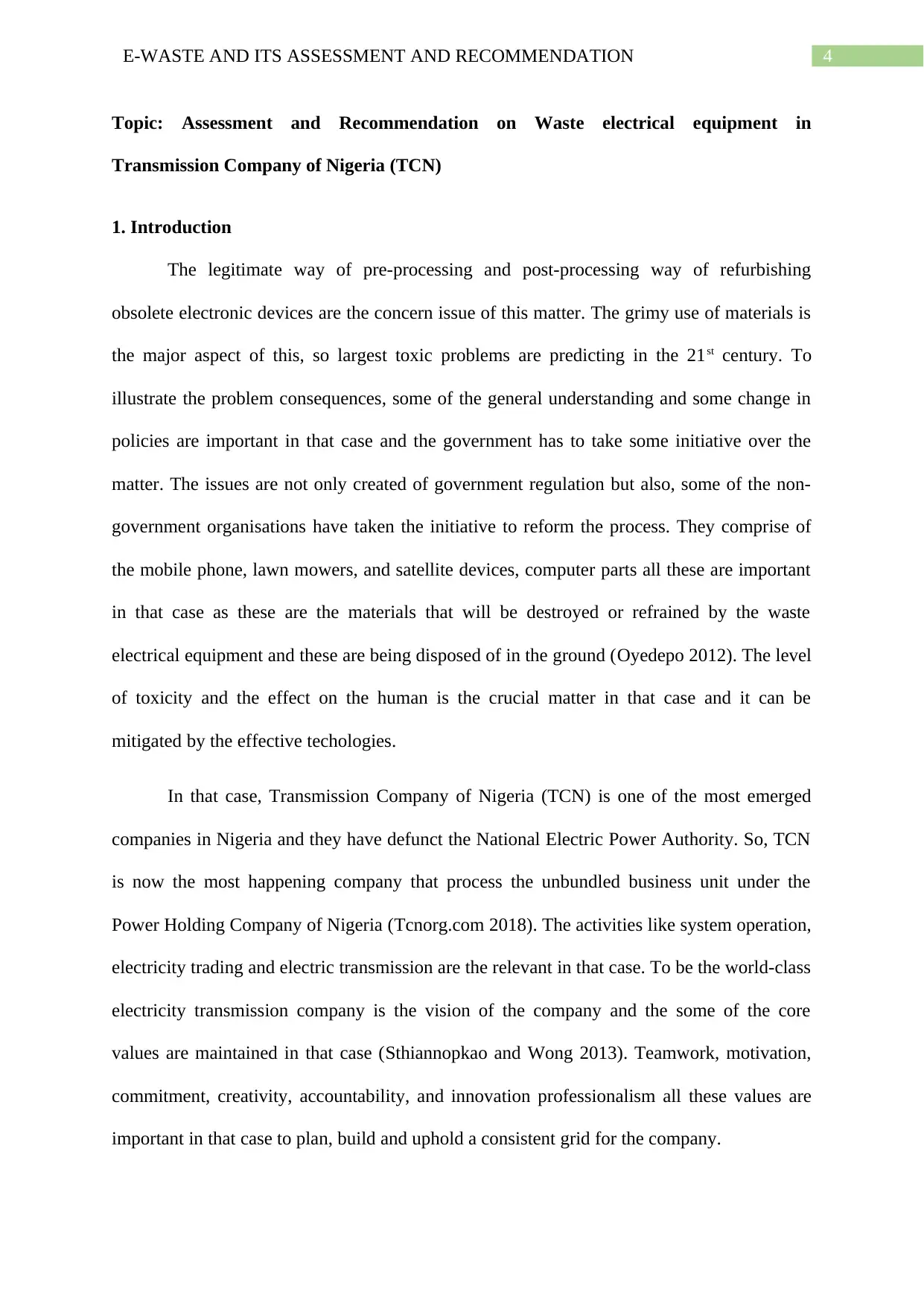
4E-WASTE AND ITS ASSESSMENT AND RECOMMENDATION
Topic: Assessment and Recommendation on Waste electrical equipment in
Transmission Company of Nigeria (TCN)
1. Introduction
The legitimate way of pre-processing and post-processing way of refurbishing
obsolete electronic devices are the concern issue of this matter. The grimy use of materials is
the major aspect of this, so largest toxic problems are predicting in the 21st century. To
illustrate the problem consequences, some of the general understanding and some change in
policies are important in that case and the government has to take some initiative over the
matter. The issues are not only created of government regulation but also, some of the non-
government organisations have taken the initiative to reform the process. They comprise of
the mobile phone, lawn mowers, and satellite devices, computer parts all these are important
in that case as these are the materials that will be destroyed or refrained by the waste
electrical equipment and these are being disposed of in the ground (Oyedepo 2012). The level
of toxicity and the effect on the human is the crucial matter in that case and it can be
mitigated by the effective techologies.
In that case, Transmission Company of Nigeria (TCN) is one of the most emerged
companies in Nigeria and they have defunct the National Electric Power Authority. So, TCN
is now the most happening company that process the unbundled business unit under the
Power Holding Company of Nigeria (Tcnorg.com 2018). The activities like system operation,
electricity trading and electric transmission are the relevant in that case. To be the world-class
electricity transmission company is the vision of the company and the some of the core
values are maintained in that case (Sthiannopkao and Wong 2013). Teamwork, motivation,
commitment, creativity, accountability, and innovation professionalism all these values are
important in that case to plan, build and uphold a consistent grid for the company.
Topic: Assessment and Recommendation on Waste electrical equipment in
Transmission Company of Nigeria (TCN)
1. Introduction
The legitimate way of pre-processing and post-processing way of refurbishing
obsolete electronic devices are the concern issue of this matter. The grimy use of materials is
the major aspect of this, so largest toxic problems are predicting in the 21st century. To
illustrate the problem consequences, some of the general understanding and some change in
policies are important in that case and the government has to take some initiative over the
matter. The issues are not only created of government regulation but also, some of the non-
government organisations have taken the initiative to reform the process. They comprise of
the mobile phone, lawn mowers, and satellite devices, computer parts all these are important
in that case as these are the materials that will be destroyed or refrained by the waste
electrical equipment and these are being disposed of in the ground (Oyedepo 2012). The level
of toxicity and the effect on the human is the crucial matter in that case and it can be
mitigated by the effective techologies.
In that case, Transmission Company of Nigeria (TCN) is one of the most emerged
companies in Nigeria and they have defunct the National Electric Power Authority. So, TCN
is now the most happening company that process the unbundled business unit under the
Power Holding Company of Nigeria (Tcnorg.com 2018). The activities like system operation,
electricity trading and electric transmission are the relevant in that case. To be the world-class
electricity transmission company is the vision of the company and the some of the core
values are maintained in that case (Sthiannopkao and Wong 2013). Teamwork, motivation,
commitment, creativity, accountability, and innovation professionalism all these values are
important in that case to plan, build and uphold a consistent grid for the company.
Paraphrase This Document
Need a fresh take? Get an instant paraphrase of this document with our AI Paraphraser
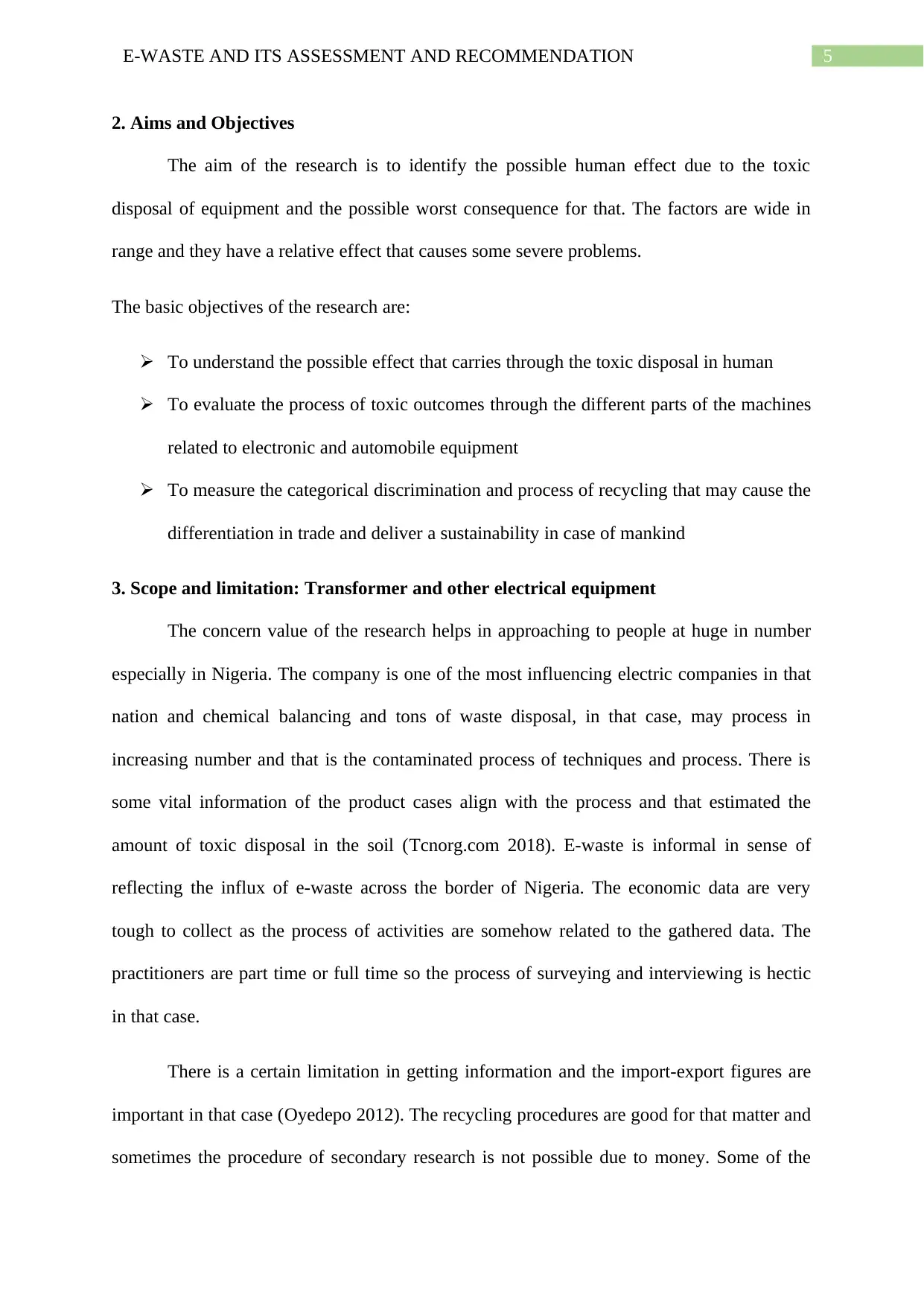
5E-WASTE AND ITS ASSESSMENT AND RECOMMENDATION
2. Aims and Objectives
The aim of the research is to identify the possible human effect due to the toxic
disposal of equipment and the possible worst consequence for that. The factors are wide in
range and they have a relative effect that causes some severe problems.
The basic objectives of the research are:
To understand the possible effect that carries through the toxic disposal in human
To evaluate the process of toxic outcomes through the different parts of the machines
related to electronic and automobile equipment
To measure the categorical discrimination and process of recycling that may cause the
differentiation in trade and deliver a sustainability in case of mankind
3. Scope and limitation: Transformer and other electrical equipment
The concern value of the research helps in approaching to people at huge in number
especially in Nigeria. The company is one of the most influencing electric companies in that
nation and chemical balancing and tons of waste disposal, in that case, may process in
increasing number and that is the contaminated process of techniques and process. There is
some vital information of the product cases align with the process and that estimated the
amount of toxic disposal in the soil (Tcnorg.com 2018). E-waste is informal in sense of
reflecting the influx of e-waste across the border of Nigeria. The economic data are very
tough to collect as the process of activities are somehow related to the gathered data. The
practitioners are part time or full time so the process of surveying and interviewing is hectic
in that case.
There is a certain limitation in getting information and the import-export figures are
important in that case (Oyedepo 2012). The recycling procedures are good for that matter and
sometimes the procedure of secondary research is not possible due to money. Some of the
2. Aims and Objectives
The aim of the research is to identify the possible human effect due to the toxic
disposal of equipment and the possible worst consequence for that. The factors are wide in
range and they have a relative effect that causes some severe problems.
The basic objectives of the research are:
To understand the possible effect that carries through the toxic disposal in human
To evaluate the process of toxic outcomes through the different parts of the machines
related to electronic and automobile equipment
To measure the categorical discrimination and process of recycling that may cause the
differentiation in trade and deliver a sustainability in case of mankind
3. Scope and limitation: Transformer and other electrical equipment
The concern value of the research helps in approaching to people at huge in number
especially in Nigeria. The company is one of the most influencing electric companies in that
nation and chemical balancing and tons of waste disposal, in that case, may process in
increasing number and that is the contaminated process of techniques and process. There is
some vital information of the product cases align with the process and that estimated the
amount of toxic disposal in the soil (Tcnorg.com 2018). E-waste is informal in sense of
reflecting the influx of e-waste across the border of Nigeria. The economic data are very
tough to collect as the process of activities are somehow related to the gathered data. The
practitioners are part time or full time so the process of surveying and interviewing is hectic
in that case.
There is a certain limitation in getting information and the import-export figures are
important in that case (Oyedepo 2012). The recycling procedures are good for that matter and
sometimes the procedure of secondary research is not possible due to money. Some of the
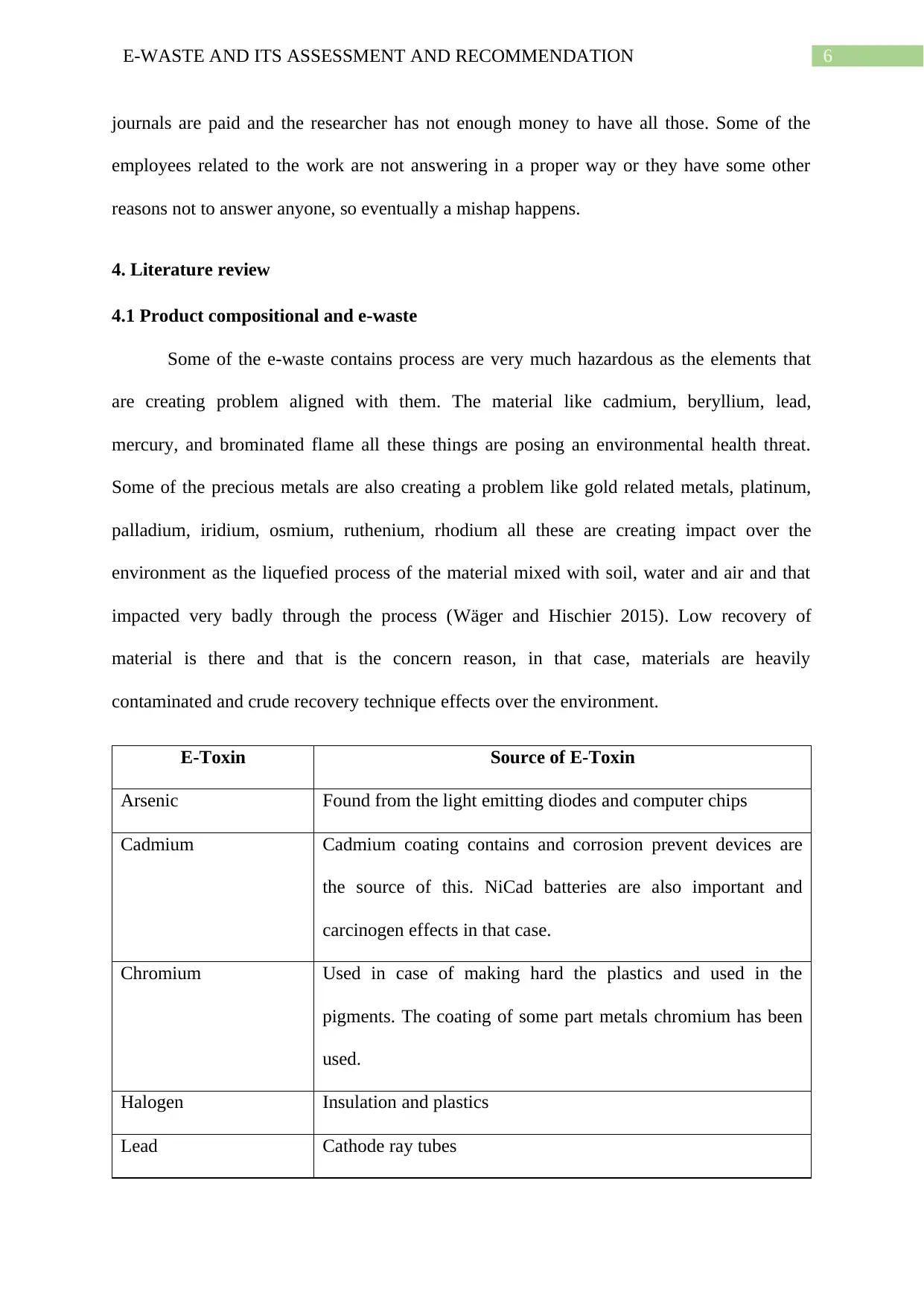
6E-WASTE AND ITS ASSESSMENT AND RECOMMENDATION
journals are paid and the researcher has not enough money to have all those. Some of the
employees related to the work are not answering in a proper way or they have some other
reasons not to answer anyone, so eventually a mishap happens.
4. Literature review
4.1 Product compositional and e-waste
Some of the e-waste contains process are very much hazardous as the elements that
are creating problem aligned with them. The material like cadmium, beryllium, lead,
mercury, and brominated flame all these things are posing an environmental health threat.
Some of the precious metals are also creating a problem like gold related metals, platinum,
palladium, iridium, osmium, ruthenium, rhodium all these are creating impact over the
environment as the liquefied process of the material mixed with soil, water and air and that
impacted very badly through the process (Wäger and Hischier 2015). Low recovery of
material is there and that is the concern reason, in that case, materials are heavily
contaminated and crude recovery technique effects over the environment.
E-Toxin Source of E-Toxin
Arsenic Found from the light emitting diodes and computer chips
Cadmium Cadmium coating contains and corrosion prevent devices are
the source of this. NiCad batteries are also important and
carcinogen effects in that case.
Chromium Used in case of making hard the plastics and used in the
pigments. The coating of some part metals chromium has been
used.
Halogen Insulation and plastics
Lead Cathode ray tubes
journals are paid and the researcher has not enough money to have all those. Some of the
employees related to the work are not answering in a proper way or they have some other
reasons not to answer anyone, so eventually a mishap happens.
4. Literature review
4.1 Product compositional and e-waste
Some of the e-waste contains process are very much hazardous as the elements that
are creating problem aligned with them. The material like cadmium, beryllium, lead,
mercury, and brominated flame all these things are posing an environmental health threat.
Some of the precious metals are also creating a problem like gold related metals, platinum,
palladium, iridium, osmium, ruthenium, rhodium all these are creating impact over the
environment as the liquefied process of the material mixed with soil, water and air and that
impacted very badly through the process (Wäger and Hischier 2015). Low recovery of
material is there and that is the concern reason, in that case, materials are heavily
contaminated and crude recovery technique effects over the environment.
E-Toxin Source of E-Toxin
Arsenic Found from the light emitting diodes and computer chips
Cadmium Cadmium coating contains and corrosion prevent devices are
the source of this. NiCad batteries are also important and
carcinogen effects in that case.
Chromium Used in case of making hard the plastics and used in the
pigments. The coating of some part metals chromium has been
used.
Halogen Insulation and plastics
Lead Cathode ray tubes
⊘ This is a preview!⊘
Do you want full access?
Subscribe today to unlock all pages.

Trusted by 1+ million students worldwide
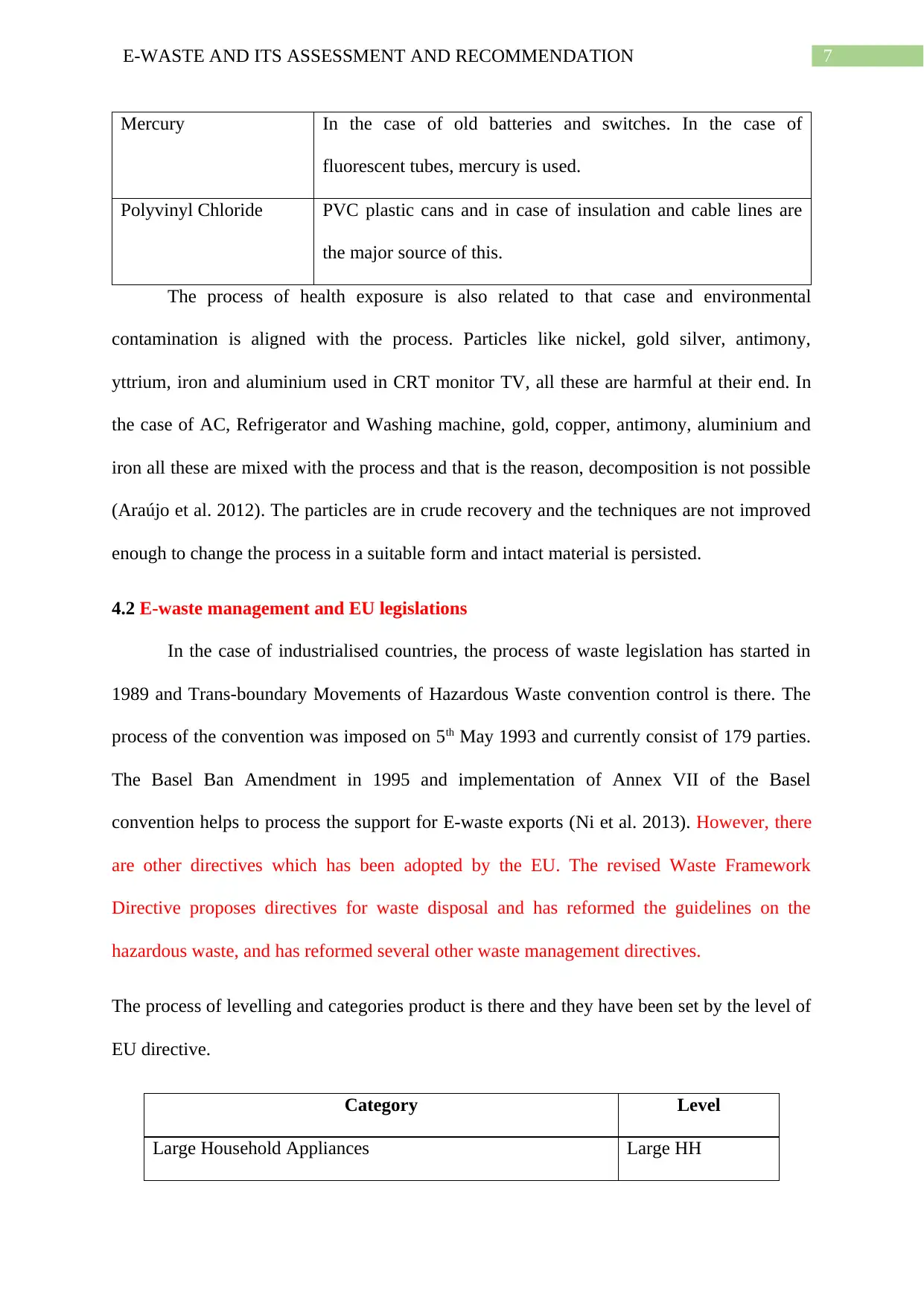
7E-WASTE AND ITS ASSESSMENT AND RECOMMENDATION
Mercury In the case of old batteries and switches. In the case of
fluorescent tubes, mercury is used.
Polyvinyl Chloride PVC plastic cans and in case of insulation and cable lines are
the major source of this.
The process of health exposure is also related to that case and environmental
contamination is aligned with the process. Particles like nickel, gold silver, antimony,
yttrium, iron and aluminium used in CRT monitor TV, all these are harmful at their end. In
the case of AC, Refrigerator and Washing machine, gold, copper, antimony, aluminium and
iron all these are mixed with the process and that is the reason, decomposition is not possible
(Araújo et al. 2012). The particles are in crude recovery and the techniques are not improved
enough to change the process in a suitable form and intact material is persisted.
4.2 E-waste management and EU legislations
In the case of industrialised countries, the process of waste legislation has started in
1989 and Trans-boundary Movements of Hazardous Waste convention control is there. The
process of the convention was imposed on 5th May 1993 and currently consist of 179 parties.
The Basel Ban Amendment in 1995 and implementation of Annex VII of the Basel
convention helps to process the support for E-waste exports (Ni et al. 2013). However, there
are other directives which has been adopted by the EU. The revised Waste Framework
Directive proposes directives for waste disposal and has reformed the guidelines on the
hazardous waste, and has reformed several other waste management directives.
The process of levelling and categories product is there and they have been set by the level of
EU directive.
Category Level
Large Household Appliances Large HH
Mercury In the case of old batteries and switches. In the case of
fluorescent tubes, mercury is used.
Polyvinyl Chloride PVC plastic cans and in case of insulation and cable lines are
the major source of this.
The process of health exposure is also related to that case and environmental
contamination is aligned with the process. Particles like nickel, gold silver, antimony,
yttrium, iron and aluminium used in CRT monitor TV, all these are harmful at their end. In
the case of AC, Refrigerator and Washing machine, gold, copper, antimony, aluminium and
iron all these are mixed with the process and that is the reason, decomposition is not possible
(Araújo et al. 2012). The particles are in crude recovery and the techniques are not improved
enough to change the process in a suitable form and intact material is persisted.
4.2 E-waste management and EU legislations
In the case of industrialised countries, the process of waste legislation has started in
1989 and Trans-boundary Movements of Hazardous Waste convention control is there. The
process of the convention was imposed on 5th May 1993 and currently consist of 179 parties.
The Basel Ban Amendment in 1995 and implementation of Annex VII of the Basel
convention helps to process the support for E-waste exports (Ni et al. 2013). However, there
are other directives which has been adopted by the EU. The revised Waste Framework
Directive proposes directives for waste disposal and has reformed the guidelines on the
hazardous waste, and has reformed several other waste management directives.
The process of levelling and categories product is there and they have been set by the level of
EU directive.
Category Level
Large Household Appliances Large HH
Paraphrase This Document
Need a fresh take? Get an instant paraphrase of this document with our AI Paraphraser
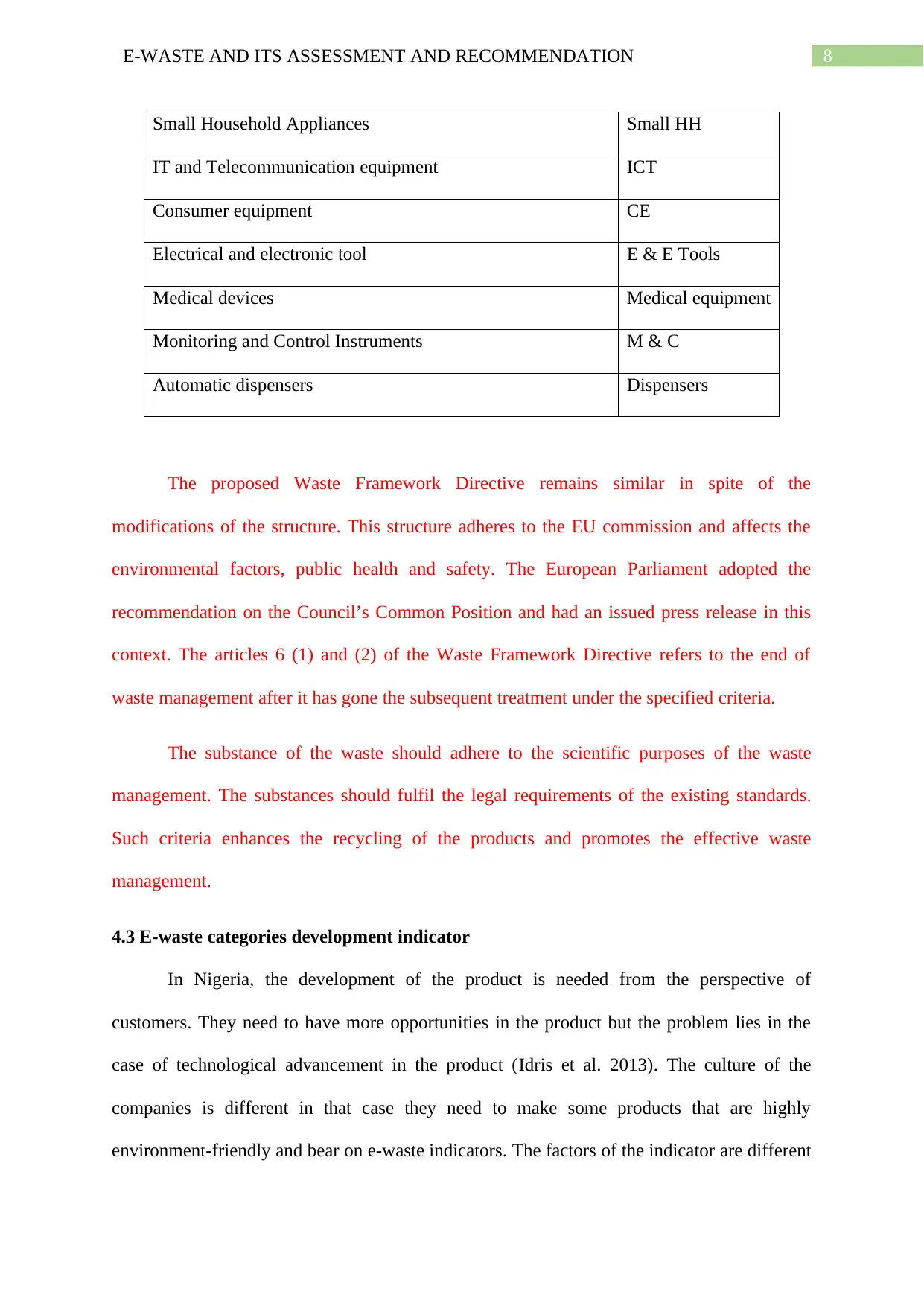
8E-WASTE AND ITS ASSESSMENT AND RECOMMENDATION
Small Household Appliances Small HH
IT and Telecommunication equipment ICT
Consumer equipment CE
Electrical and electronic tool E & E Tools
Medical devices Medical equipment
Monitoring and Control Instruments M & C
Automatic dispensers Dispensers
The proposed Waste Framework Directive remains similar in spite of the
modifications of the structure. This structure adheres to the EU commission and affects the
environmental factors, public health and safety. The European Parliament adopted the
recommendation on the Council’s Common Position and had an issued press release in this
context. The articles 6 (1) and (2) of the Waste Framework Directive refers to the end of
waste management after it has gone the subsequent treatment under the specified criteria.
The substance of the waste should adhere to the scientific purposes of the waste
management. The substances should fulfil the legal requirements of the existing standards.
Such criteria enhances the recycling of the products and promotes the effective waste
management.
4.3 E-waste categories development indicator
In Nigeria, the development of the product is needed from the perspective of
customers. They need to have more opportunities in the product but the problem lies in the
case of technological advancement in the product (Idris et al. 2013). The culture of the
companies is different in that case they need to make some products that are highly
environment-friendly and bear on e-waste indicators. The factors of the indicator are different
Small Household Appliances Small HH
IT and Telecommunication equipment ICT
Consumer equipment CE
Electrical and electronic tool E & E Tools
Medical devices Medical equipment
Monitoring and Control Instruments M & C
Automatic dispensers Dispensers
The proposed Waste Framework Directive remains similar in spite of the
modifications of the structure. This structure adheres to the EU commission and affects the
environmental factors, public health and safety. The European Parliament adopted the
recommendation on the Council’s Common Position and had an issued press release in this
context. The articles 6 (1) and (2) of the Waste Framework Directive refers to the end of
waste management after it has gone the subsequent treatment under the specified criteria.
The substance of the waste should adhere to the scientific purposes of the waste
management. The substances should fulfil the legal requirements of the existing standards.
Such criteria enhances the recycling of the products and promotes the effective waste
management.
4.3 E-waste categories development indicator
In Nigeria, the development of the product is needed from the perspective of
customers. They need to have more opportunities in the product but the problem lies in the
case of technological advancement in the product (Idris et al. 2013). The culture of the
companies is different in that case they need to make some products that are highly
environment-friendly and bear on e-waste indicators. The factors of the indicator are different
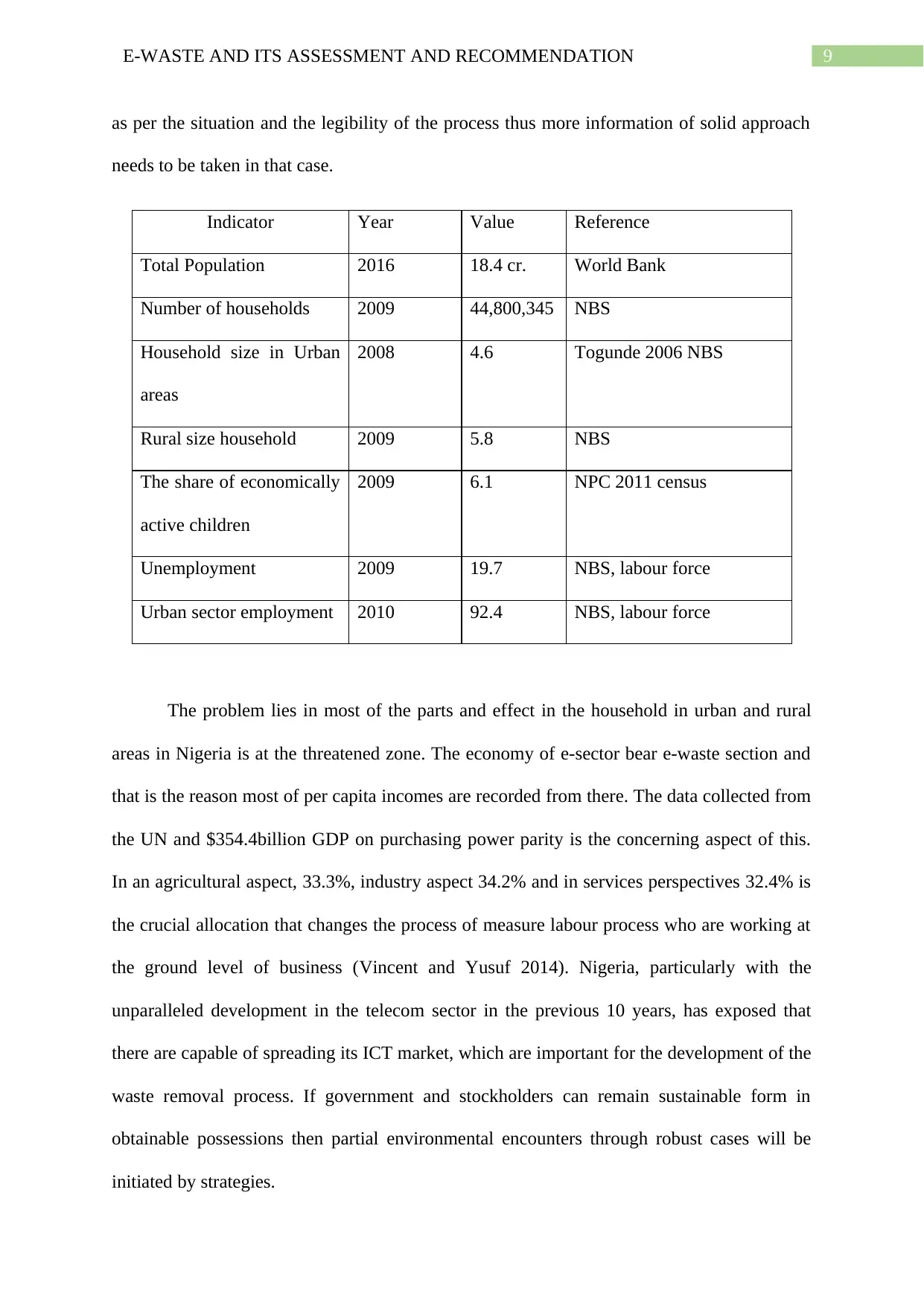
9E-WASTE AND ITS ASSESSMENT AND RECOMMENDATION
as per the situation and the legibility of the process thus more information of solid approach
needs to be taken in that case.
Indicator Year Value Reference
Total Population 2016 18.4 cr. World Bank
Number of households 2009 44,800,345 NBS
Household size in Urban
areas
2008 4.6 Togunde 2006 NBS
Rural size household 2009 5.8 NBS
The share of economically
active children
2009 6.1 NPC 2011 census
Unemployment 2009 19.7 NBS, labour force
Urban sector employment 2010 92.4 NBS, labour force
The problem lies in most of the parts and effect in the household in urban and rural
areas in Nigeria is at the threatened zone. The economy of e-sector bear e-waste section and
that is the reason most of per capita incomes are recorded from there. The data collected from
the UN and $354.4billion GDP on purchasing power parity is the concerning aspect of this.
In an agricultural aspect, 33.3%, industry aspect 34.2% and in services perspectives 32.4% is
the crucial allocation that changes the process of measure labour process who are working at
the ground level of business (Vincent and Yusuf 2014). Nigeria, particularly with the
unparalleled development in the telecom sector in the previous 10 years, has exposed that
there are capable of spreading its ICT market, which are important for the development of the
waste removal process. If government and stockholders can remain sustainable form in
obtainable possessions then partial environmental encounters through robust cases will be
initiated by strategies.
as per the situation and the legibility of the process thus more information of solid approach
needs to be taken in that case.
Indicator Year Value Reference
Total Population 2016 18.4 cr. World Bank
Number of households 2009 44,800,345 NBS
Household size in Urban
areas
2008 4.6 Togunde 2006 NBS
Rural size household 2009 5.8 NBS
The share of economically
active children
2009 6.1 NPC 2011 census
Unemployment 2009 19.7 NBS, labour force
Urban sector employment 2010 92.4 NBS, labour force
The problem lies in most of the parts and effect in the household in urban and rural
areas in Nigeria is at the threatened zone. The economy of e-sector bear e-waste section and
that is the reason most of per capita incomes are recorded from there. The data collected from
the UN and $354.4billion GDP on purchasing power parity is the concerning aspect of this.
In an agricultural aspect, 33.3%, industry aspect 34.2% and in services perspectives 32.4% is
the crucial allocation that changes the process of measure labour process who are working at
the ground level of business (Vincent and Yusuf 2014). Nigeria, particularly with the
unparalleled development in the telecom sector in the previous 10 years, has exposed that
there are capable of spreading its ICT market, which are important for the development of the
waste removal process. If government and stockholders can remain sustainable form in
obtainable possessions then partial environmental encounters through robust cases will be
initiated by strategies.
⊘ This is a preview!⊘
Do you want full access?
Subscribe today to unlock all pages.

Trusted by 1+ million students worldwide
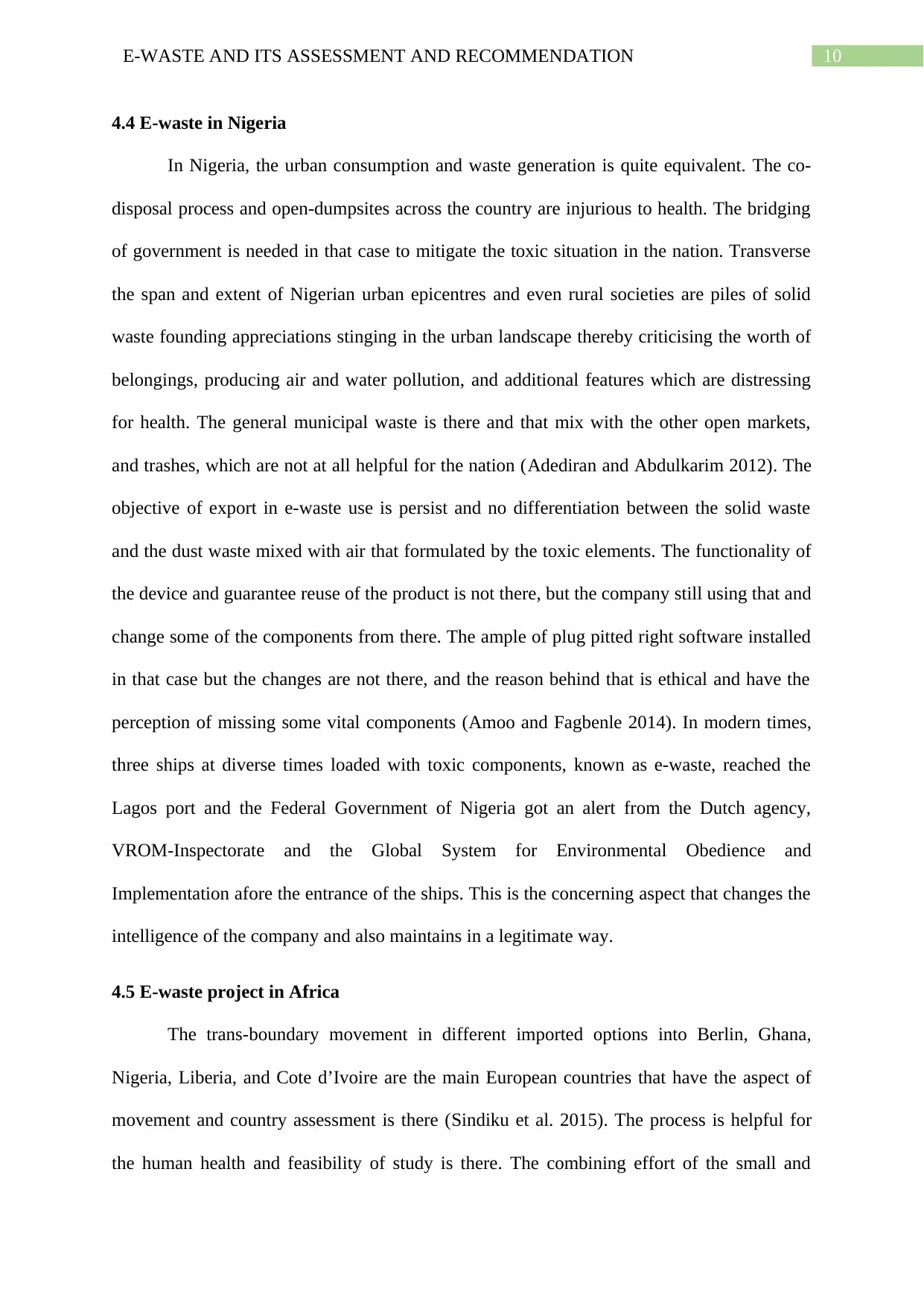
10E-WASTE AND ITS ASSESSMENT AND RECOMMENDATION
4.4 E-waste in Nigeria
In Nigeria, the urban consumption and waste generation is quite equivalent. The co-
disposal process and open-dumpsites across the country are injurious to health. The bridging
of government is needed in that case to mitigate the toxic situation in the nation. Transverse
the span and extent of Nigerian urban epicentres and even rural societies are piles of solid
waste founding appreciations stinging in the urban landscape thereby criticising the worth of
belongings, producing air and water pollution, and additional features which are distressing
for health. The general municipal waste is there and that mix with the other open markets,
and trashes, which are not at all helpful for the nation (Adediran and Abdulkarim 2012). The
objective of export in e-waste use is persist and no differentiation between the solid waste
and the dust waste mixed with air that formulated by the toxic elements. The functionality of
the device and guarantee reuse of the product is not there, but the company still using that and
change some of the components from there. The ample of plug pitted right software installed
in that case but the changes are not there, and the reason behind that is ethical and have the
perception of missing some vital components (Amoo and Fagbenle 2014). In modern times,
three ships at diverse times loaded with toxic components, known as e-waste, reached the
Lagos port and the Federal Government of Nigeria got an alert from the Dutch agency,
VROM-Inspectorate and the Global System for Environmental Obedience and
Implementation afore the entrance of the ships. This is the concerning aspect that changes the
intelligence of the company and also maintains in a legitimate way.
4.5 E-waste project in Africa
The trans-boundary movement in different imported options into Berlin, Ghana,
Nigeria, Liberia, and Cote d’Ivoire are the main European countries that have the aspect of
movement and country assessment is there (Sindiku et al. 2015). The process is helpful for
the human health and feasibility of study is there. The combining effort of the small and
4.4 E-waste in Nigeria
In Nigeria, the urban consumption and waste generation is quite equivalent. The co-
disposal process and open-dumpsites across the country are injurious to health. The bridging
of government is needed in that case to mitigate the toxic situation in the nation. Transverse
the span and extent of Nigerian urban epicentres and even rural societies are piles of solid
waste founding appreciations stinging in the urban landscape thereby criticising the worth of
belongings, producing air and water pollution, and additional features which are distressing
for health. The general municipal waste is there and that mix with the other open markets,
and trashes, which are not at all helpful for the nation (Adediran and Abdulkarim 2012). The
objective of export in e-waste use is persist and no differentiation between the solid waste
and the dust waste mixed with air that formulated by the toxic elements. The functionality of
the device and guarantee reuse of the product is not there, but the company still using that and
change some of the components from there. The ample of plug pitted right software installed
in that case but the changes are not there, and the reason behind that is ethical and have the
perception of missing some vital components (Amoo and Fagbenle 2014). In modern times,
three ships at diverse times loaded with toxic components, known as e-waste, reached the
Lagos port and the Federal Government of Nigeria got an alert from the Dutch agency,
VROM-Inspectorate and the Global System for Environmental Obedience and
Implementation afore the entrance of the ships. This is the concerning aspect that changes the
intelligence of the company and also maintains in a legitimate way.
4.5 E-waste project in Africa
The trans-boundary movement in different imported options into Berlin, Ghana,
Nigeria, Liberia, and Cote d’Ivoire are the main European countries that have the aspect of
movement and country assessment is there (Sindiku et al. 2015). The process is helpful for
the human health and feasibility of study is there. The combining effort of the small and
Paraphrase This Document
Need a fresh take? Get an instant paraphrase of this document with our AI Paraphraser
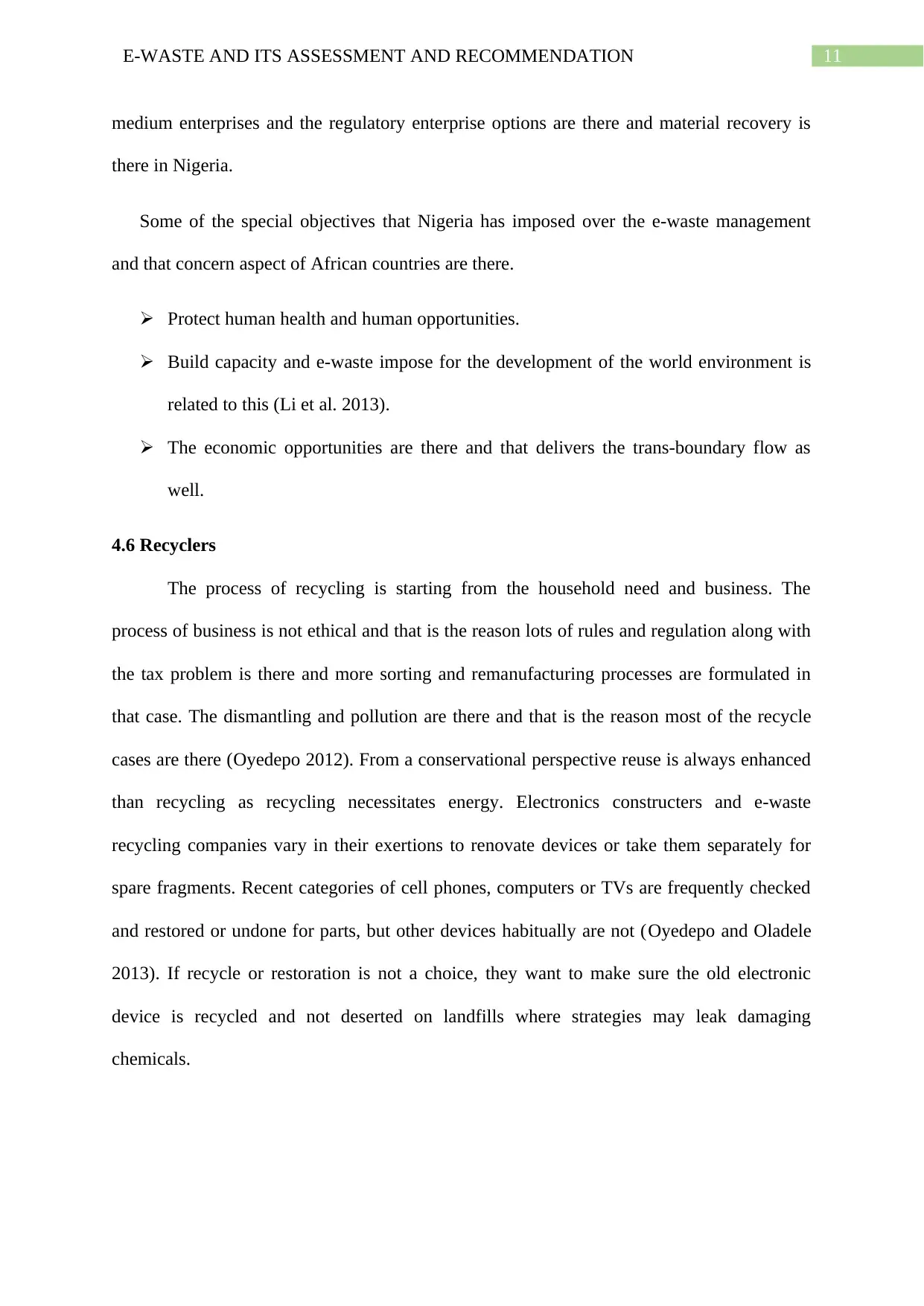
11E-WASTE AND ITS ASSESSMENT AND RECOMMENDATION
medium enterprises and the regulatory enterprise options are there and material recovery is
there in Nigeria.
Some of the special objectives that Nigeria has imposed over the e-waste management
and that concern aspect of African countries are there.
Protect human health and human opportunities.
Build capacity and e-waste impose for the development of the world environment is
related to this (Li et al. 2013).
The economic opportunities are there and that delivers the trans-boundary flow as
well.
4.6 Recyclers
The process of recycling is starting from the household need and business. The
process of business is not ethical and that is the reason lots of rules and regulation along with
the tax problem is there and more sorting and remanufacturing processes are formulated in
that case. The dismantling and pollution are there and that is the reason most of the recycle
cases are there (Oyedepo 2012). From a conservational perspective reuse is always enhanced
than recycling as recycling necessitates energy. Electronics constructers and e-waste
recycling companies vary in their exertions to renovate devices or take them separately for
spare fragments. Recent categories of cell phones, computers or TVs are frequently checked
and restored or undone for parts, but other devices habitually are not (Oyedepo and Oladele
2013). If recycle or restoration is not a choice, they want to make sure the old electronic
device is recycled and not deserted on landfills where strategies may leak damaging
chemicals.
medium enterprises and the regulatory enterprise options are there and material recovery is
there in Nigeria.
Some of the special objectives that Nigeria has imposed over the e-waste management
and that concern aspect of African countries are there.
Protect human health and human opportunities.
Build capacity and e-waste impose for the development of the world environment is
related to this (Li et al. 2013).
The economic opportunities are there and that delivers the trans-boundary flow as
well.
4.6 Recyclers
The process of recycling is starting from the household need and business. The
process of business is not ethical and that is the reason lots of rules and regulation along with
the tax problem is there and more sorting and remanufacturing processes are formulated in
that case. The dismantling and pollution are there and that is the reason most of the recycle
cases are there (Oyedepo 2012). From a conservational perspective reuse is always enhanced
than recycling as recycling necessitates energy. Electronics constructers and e-waste
recycling companies vary in their exertions to renovate devices or take them separately for
spare fragments. Recent categories of cell phones, computers or TVs are frequently checked
and restored or undone for parts, but other devices habitually are not (Oyedepo and Oladele
2013). If recycle or restoration is not a choice, they want to make sure the old electronic
device is recycled and not deserted on landfills where strategies may leak damaging
chemicals.
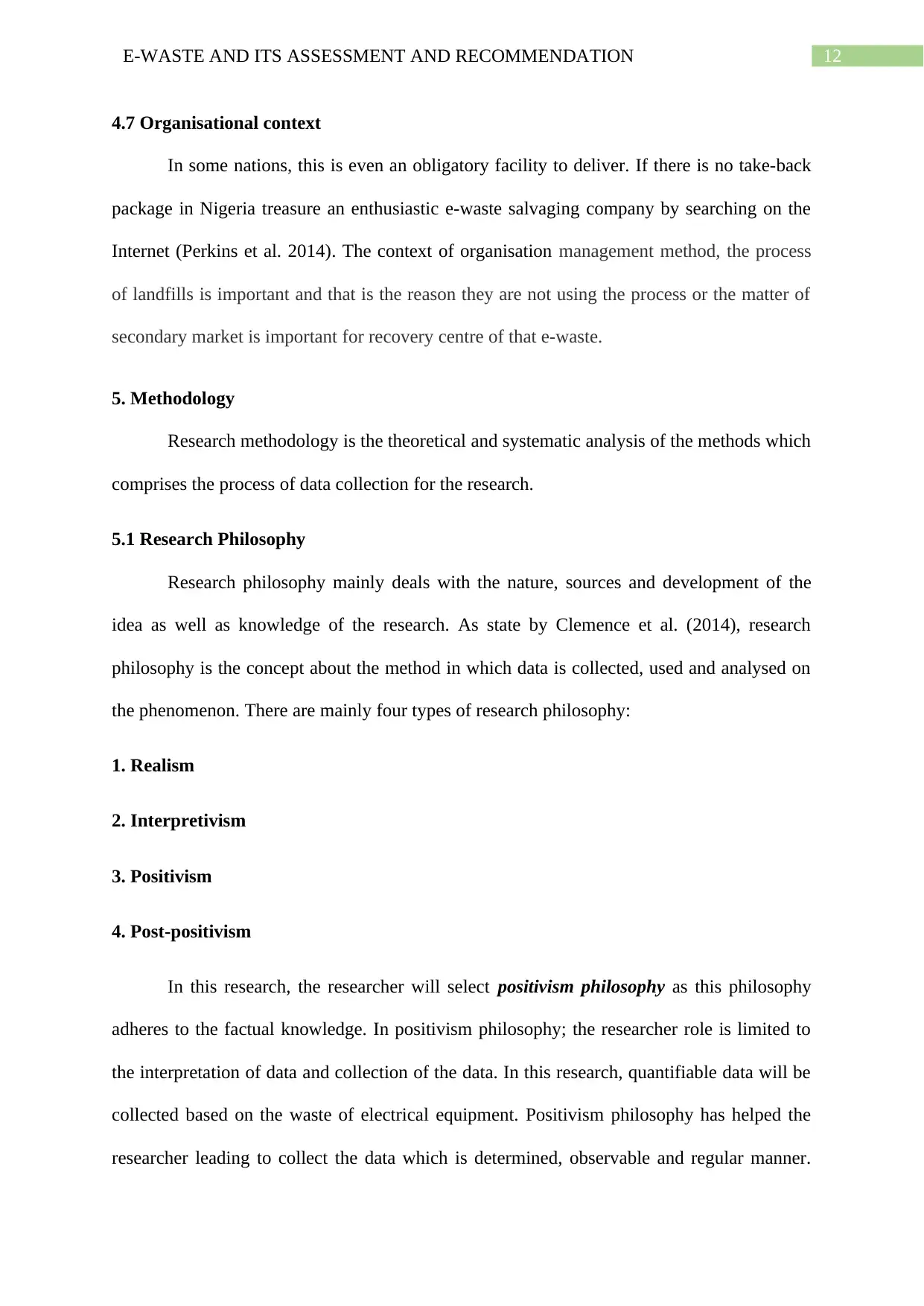
12E-WASTE AND ITS ASSESSMENT AND RECOMMENDATION
4.7 Organisational context
In some nations, this is even an obligatory facility to deliver. If there is no take-back
package in Nigeria treasure an enthusiastic e-waste salvaging company by searching on the
Internet (Perkins et al. 2014). The context of organisation management method, the process
of landfills is important and that is the reason they are not using the process or the matter of
secondary market is important for recovery centre of that e-waste.
5. Methodology
Research methodology is the theoretical and systematic analysis of the methods which
comprises the process of data collection for the research.
5.1 Research Philosophy
Research philosophy mainly deals with the nature, sources and development of the
idea as well as knowledge of the research. As state by Clemence et al. (2014), research
philosophy is the concept about the method in which data is collected, used and analysed on
the phenomenon. There are mainly four types of research philosophy:
1. Realism
2. Interpretivism
3. Positivism
4. Post-positivism
In this research, the researcher will select positivism philosophy as this philosophy
adheres to the factual knowledge. In positivism philosophy; the researcher role is limited to
the interpretation of data and collection of the data. In this research, quantifiable data will be
collected based on the waste of electrical equipment. Positivism philosophy has helped the
researcher leading to collect the data which is determined, observable and regular manner.
4.7 Organisational context
In some nations, this is even an obligatory facility to deliver. If there is no take-back
package in Nigeria treasure an enthusiastic e-waste salvaging company by searching on the
Internet (Perkins et al. 2014). The context of organisation management method, the process
of landfills is important and that is the reason they are not using the process or the matter of
secondary market is important for recovery centre of that e-waste.
5. Methodology
Research methodology is the theoretical and systematic analysis of the methods which
comprises the process of data collection for the research.
5.1 Research Philosophy
Research philosophy mainly deals with the nature, sources and development of the
idea as well as knowledge of the research. As state by Clemence et al. (2014), research
philosophy is the concept about the method in which data is collected, used and analysed on
the phenomenon. There are mainly four types of research philosophy:
1. Realism
2. Interpretivism
3. Positivism
4. Post-positivism
In this research, the researcher will select positivism philosophy as this philosophy
adheres to the factual knowledge. In positivism philosophy; the researcher role is limited to
the interpretation of data and collection of the data. In this research, quantifiable data will be
collected based on the waste of electrical equipment. Positivism philosophy has helped the
researcher leading to collect the data which is determined, observable and regular manner.
⊘ This is a preview!⊘
Do you want full access?
Subscribe today to unlock all pages.

Trusted by 1+ million students worldwide
1 out of 23
Your All-in-One AI-Powered Toolkit for Academic Success.
+13062052269
info@desklib.com
Available 24*7 on WhatsApp / Email
![[object Object]](/_next/static/media/star-bottom.7253800d.svg)
Unlock your academic potential
Copyright © 2020–2025 A2Z Services. All Rights Reserved. Developed and managed by ZUCOL.